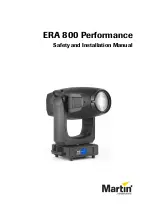
high frequency AC quantities above 80kHz of the
trigger signal. This mode is suitable for observing low
frequency signals.
Low frequency suppression mode, i.e. rejecting
low frequency AC quantities below 80kHz of the
trigger signal. This mode is suitable for observing high
frequency signals.
3. This reading is the rising edge level.
4. Trigger status is displayed as follows :
UTD1000 User Manual
Display Zone :
Apart from the waveform display zone, the display panel
also features other details about the waveform and
the unit’s control setup. These are explained by their
sequence numbers in the above figure :
1. Trigger source status display is as follows :
A. Select signals of Channel A as the trigger signal
source.
B. Select signals of Channel B as the trigger signal
source.
AB. Select signals of Channels A and B as the alternate
trigger signal source
2. Trigger coupling mode display is as follows :
AC trigger coupling mode, i.e. only AC quantities
larger than 10Hz of the trigger signals can pass the
coupling capacitor. The DC will be intercepted. This is a
general trigger coupling mode.
DC trigger coupling mode, i.e. allowing both AC and
DC quantities of the trigger signal to pass through to the
trigger circuit. This mode is suitable for observing ultra-
low frequency signals.
High frequency suppression mode, i.e. rejecting
The Oscilloscope is acquiring pre-trigger
data. All triggers are ignored.
The Oscilloscope has acquired all pre-
trigger data and is ready to accept trigger.
The Oscilloscope has detected one trigger
and is acquiring post-trigger data.
The Oscilloscope has stopped acquiring
waveform data.
The Oscilloscope is in automatic mode
and acquiring waveform with no trigger.
The Oscilloscope is continuously acquiring
and displaying waveform in the scan mode.
ARMED
READY
TRIG’ED
STOP
AUTO
SCAN
Summary of Contents for UTD1000 Series
Page 1: ...P N 110401104796X MAY 2018 REV 3 ...
Page 2: ......
Page 100: ... UTD1000 User Manual This user manual may be revised without prior notice ...
Page 101: ......














































